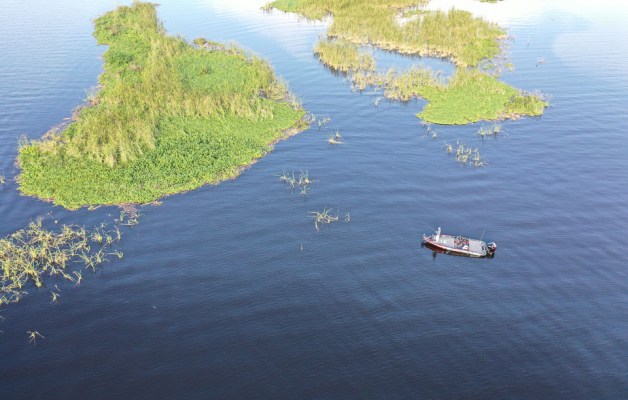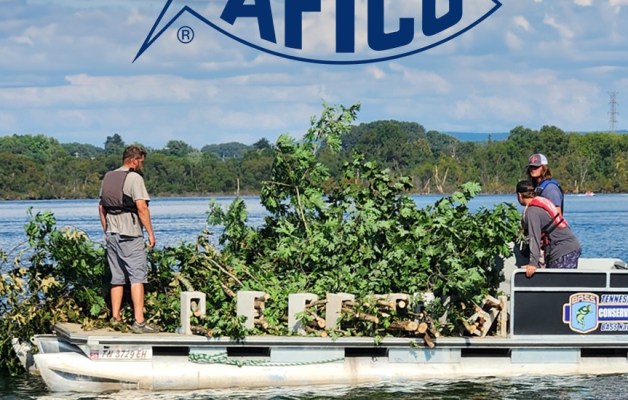
In large, Northern waters, smallmouth bass aren’t what they used to be.
They’re much more. So much more that they’ve often supplanted largemouth bass as the primary targets for fishermen, especially tournament anglers. Fewer than 10,000 smallies were weighed in during tournaments on the eastern basin of Lake Ontario and the St. Lawrence River during 2014, compared to about 14,000 in 2019.
“These fisheries have changed dramatically in the last 20 years and are currently producing an astounding number of gigantic fish,” said Bruce Tufts, a professor and black bass specialist at Queen’s University in Kingston, Ontario, who is also an avid angler.
“In contrast to what catch statistics show on smaller waters, smallmouth bass in the Great Lakes are now much bigger than largemouth bass at any given age,” he added. “We’ve been collecting information from these [tournaments], and our data shows that the average largemouth bass weighed in on these waters is 3 pounds, whereas the average smallmouth bass is 3.7 pounds.”
Ten years ago, a 20-pound limit of five fish daily during a three-day event on eastern Lake Ontario and the St. Lawrence River was rare. But during the 2018 Thousand Islands Open out of Kingston, anglers checked in with 111 limits of more than 20 pounds, with 20 that exceeded 25 pounds.
“Teams needed more than 60 pounds over three days [with a 15-fish limit] to finish in even the Top 30, and the winner had more than 75 pounds,” he said.
Smallies aren’t just averaging more these days, either. They’re also growing to record proportions. In 2016, an 8.25-pound bronzeback from the St. Lawrence River tied a New York record first established in 1995, while a state-record fish from Michigan’s Indian River checked in at 9.98 pounds — nearly double-digits! Before that, the state record of 9.25 pounds had been in place since 1906.
What’s going on here is no mystery to most serious bass anglers. Smallies are growing fatter as they feast on round gobies, an invasive species introduced into the Great Lakes nearly two decades ago. As the years have passed and gobies have thrived, they’ve evolved from a tasty, calorie-heavy snack to the dominant menu item.
A study from several years ago on Lake Erie showed the goby was observed in 73.3% of smallmouth bass diets, while the crawfish had declined to 5.8%.
More recently, Tufts revealed that stomach contents from smallmouth bass captured on Lake Ontario consisted of more than 90% round gobies. By contrast, he added, gobies make up less than half of the diet of largemouth bass that “probably still eat whatever happens to swim too close.”
One smallie, he pointed out, had 17 gobies in its belly!
“We’ve reached a time where all of the adult smallmouth in the system have been feeding on gobies their entire lives,” Tufts said. “This has created an incredible trophy fishery.”
Now for the bad news.
“When I listen to people talking about the current state of these fisheries, it concerns me that there are a lot of misconceptions within the angling community,” Tufts said. “Most importantly, it is essential to recognize that incredible tournament weights and more big fish being caught is not necessarily an indication that there are greater numbers of fish in the population.”
He added, “A lot of science these days is emphasizing that ‘big, old fish’ are really important for the genetics of fish populations. Our mark/recapture studies of tournament fish on Lake Ontario and the St. Lawrence River show that there are fewer adult fish out there than most people realize, with hundreds of recaptures of our tagged fish.”
And, as it turns out, dietary preference isn’t the only difference between Northern smallmouth and largemouth. As just one example, smallies are less tolerant of low oxygen.
“Tournament anglers and organizers are realizing that it is much more difficult to keep these large, trophy smallmouth alive in a traditional tournament format,” the biologist continued.
That’s why Tufts and other biologists believe that distinctions in management and angler habits will be necessary to address the Northern bronzeback’s unique vulnerabilities, as reflected in low overall numbers. Smallmouth abundance peaked in the eastern basin of Lake Ontario in 1988. Today, it’s less than 25% of that level, with managers especially concerned about the low survival rate of young fish.
Fortunately, though, no indication exists that the population is declining further, according to Jana Lantry, a biologist with the New York Department of Environmental Conservation.
“The current smallmouth bass population remains at the same relatively low level it has been since the mid-1990s,” she added, citing several possible contributing factors. They include tournaments, cormorants and damage to quantity and quality of spawning habitat by invasive species, such as Cladophora, a benthic alga. Also, filtering by zebra mussels has made the water clearer, pushing the bass deeper, and overall productivity has been reduced.
“Smallmouth bass year-class production has remained relatively poor, despite conditions that would typically favor good production,” she added, citing warmer than average water temperatures.
“For decades, smallmouth bass management — and black bass management in the broader sense — in Northern states has been on autopilot because the state agencies were focused more on cool- and cold-water species like walleye, perch, trout, salmon and the like,” said Gene Gilliland, national conservation director for B.A.S.S.
“That’s what their constituents demanded.
But in the last 10 years, we’ve seen a huge increase in the popularity of smallmouth fishing across the country, and now those agencies are starting to realize that they need to invest more into research that allows them to better manage those fisheries.”
Confirming Tufts’ concern about the population dynamics of smallmouth bass in the Great Lakes and other large Northern waters, he continued, “My guess is that as more is learned, we will find that decades-old management schemes will not maintain the quality of these populations, and both agency and angler are going to have to learn to deal with a new paradigm.
“With fish that typically grow slowly and get very old, highly variable recruitment in some cases, unknown influences of climate change on food webs and habitat, and both good and bad impacts of invasive species … it makes for a challenging puzzle to piece together.”
Natural variations in water levels and weather always have contributed and always will contribute to shifts in populations of fish, including smallmouth. Managers can’t do anything about that. And, as Gilliland suggested, climate-change impacts remain mysteries still to be explored. If anything, moderating winters likely provide smallies with better growing conditions.
But there are some things we do know and some things we can do to help sustain Northern smallmouth fisheries.
For one, we know that the smallmouth/goby connection goes both ways. “Round gobies are quick to pounce on eggs and bottom fry if the guarding male smallmouth is angled [removed from the nest],” Tufts said.
That means these invaders, as they’ve become more numerous and widespread, have had an increasingly negative impact. That’s especially the case in recent years, since angling pressure for smallmouth has been so intense, exposing more and more nests to predation.
“With bigger boats, better electronics and social media, more anglers have also learned how to find and catch these big fish,” Tufts explained. “This increased fishing pressure could be contributing to changes in fish behavior. But it could also be changing population numbers in ways that are not immediately obvious.”
Both Ontario and New York already have addressed protecting the smallmouth spawn with regulations. For decades, the latter has not allowed fishing for bass, including catch and release, in counties bordering Lake Ontario and the St. Lawrence until the third Saturday in June. Ontario, meanwhile, just took protection one step further, delaying the season-opener for smallmouth bass in Lake Ontario and the river for two weeks, to the first Saturday in July.
“The regulation changes are pretty unique,” Tufts said. “Largemouth bass spawn in shallower, warmer water and are mostly finished by the third Saturday in June, so the start date for largemouth stayed the same. For smallmouth, however, the start of the season was delayed, based on the findings in our research and scientific publication.
“The other unique twist was that the later spawning on these waters provides a window for an early season prior to spawning that we have never had here. So, there is now an early bass season that starts on Jan. 1 and goes until May 10, when it then closes for the spawn.”
On the New York side, Lantry said, “A more recent consideration is the potential impact associated with increased tournament pressure now taking place on these resources.”
Also, she added, while these trophy fisheries are “great for local economies, many are not checking bass regulations before heading out on the water and are targeting bass during the closed season.”
Reducing the daily limit could be one more way to help sustain the fishery. Based largely on Tufts’ research, the largest multiday tournament on the Canadian side, the Thousand Islands Open, has changed its daily team limit from five to four fish per day.
“The rationale is that this would cause an immediate reduction of mortalities by at least 20%,” he said. “It makes it easier for anglers to care for their fish and reduce stresses resulting from crowding and/or low oxygen.”
A study using a video recorder showed the severity of stress and injury to smallmouth when confined in the livewells of boats traveling in rough water on Lake Ontario. Ten of 28 fish lost their equilibrium and became inverted. Additionally, “livewell transport also resulted in elevations of intracellular enzymes in blood plasma that were used as indicators of cell damage.”
A way to minimize harm, the authors suggest, could be to add padding to livewells. Many anglers now use “pool noodles” to cushion the ride.
Another study, Tufts said, “showed that smallmouth condition continues to decline in a livewell if they are not fizzed, and that fizzing is more effective than fin clips.
“It also points out that fizzing should be done by anglers shortly after the fish is caught, not by tournament staff after the weigh-in, which is too late for most fish with barotrauma issues.”
As they ponder these changes and recommendations, “bass anglers need to be open-minded and look past today,” Gilliland said. “They need to listen to good science and look at what is best for the fishery in the long run, and that may mean compromising with managers on regulations and restrictions.”
At the same time, he added, “managers need to consider the user as well as the resource in crafting those regulations. They need to get all the stakeholders at the table and consider input on angler needs and wants.”BT
Smallmouth fizzing
Smallmouth bass are more likely to require fizzing than largemouth. That’s typically because they’re caught at greater depths, and their vulnerability to stress also makes them more susceptible to barotrauma, which is an overinflation of the swim bladder.
“Bass will give you clear signs they are suffering, and you need to act quickly to ensure their welfare,” said Barb Elliott, conservation director for the New York B.A.S.S. Nation and an expert on treatment.
“A fish that is on its side or upside down at the water’s surface each time you open the livewell needs treatment. And it needs relief now, not at the weigh-in hours later. Damage to its internal organs can start the minute you lift the fish from the water.”
Use an 18-gauge 1 1/2-inch hypodermic needle equipped with a reamer (to keep tissue from plugging the needle) to pierce the skin of the fish at predetermined points on the side (not through the mouth), thus deflating the swim bladder.
“This releases excess gases and returns the fish to neutral buoyancy,” she added.
Neutral buoyancy is the point at which the fish neither sinks nor floats. “This is the most important part of the technique to learn and can only be determined while the fish is in the water,” Elliott said. “You do not release gas for a certain amount of time, nor do you count to three or five or whatever. You withdraw the needle at the point the fish no longer sinks or floats.”
She concluded, “Before you poke a hole in the side of a bass to deflate the bladder, though, you should make certain that livewell conditions are optimal in terms of dissolved oxygen, temperature and water quality.”
You can view videos demonstrating the technique for proper fizzing procedure on Bassmaster.com.





